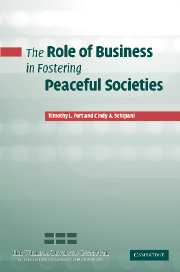Book contents
- Frontmatter
- Contents
- List of tables
- Acknowledgements
- Introduction
- Part I The plausibility of connecting business and peace
- Part II Current standards and their amenability to peace
- Part III Two illustrative issues: gender equality and ecology
- 5 Gender, voice, and correlations with peace
- 6 The ecological challenges of war: the natural environment and disease
- Conclusion
- Index
5 - Gender, voice, and correlations with peace
Published online by Cambridge University Press: 22 September 2009
- Frontmatter
- Contents
- List of tables
- Acknowledgements
- Introduction
- Part I The plausibility of connecting business and peace
- Part II Current standards and their amenability to peace
- Part III Two illustrative issues: gender equality and ecology
- 5 Gender, voice, and correlations with peace
- 6 The ecological challenges of war: the natural environment and disease
- Conclusion
- Index
Summary
In developing countries, involving women in the economy as wage earners can “lead to output gains and a reduction in poverty in general.” As has been argued elsewhere, a reduction in poverty promotes stability and leads to a more peaceful society. As the locus of production shifts away from the home, an initial decline in employment opportunities may occur. When women are transitioning in society into the workforce, violence may increase. However, when women have attained status through economic empowerment, the violence and decline in employment opportunities disappear and both women and men benefit.
A significant factor affecting the participation rate of women is the dominant religion in the country. Approximately one-third of the variation in participation rates between countries can be explained by religion. Such statistics have led to a call for secularization of the law in some countries such as India because traditional interpretations marginalize the perspective of women. Secularization is justified as a matter of social utility, logic, and modern values. Additionally, traditional interpretation is only one possible interpretation, and “common understanding” is sometimes not the best interpretation. Depending on the interpretation of Islamic Law, for example, girls have a right to education on a par with boys in their family and a right to work and earn before and after marriage, or they do not. This can be seen in the societies of Turkey and Afghanistan in 2000.
The statistics regarding violence in today's society are staggering.
- Type
- Chapter
- Information
- The Role of Business in Fostering Peaceful Societies , pp. 143 - 182Publisher: Cambridge University PressPrint publication year: 2004

